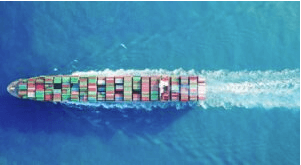Calculating the total sea freight costs is not always as simple as it seems at first glance. Even though the rate for sea transport (or the combination of several rates multimodal options) is the largest part of the total price, in most cases surcharges, duties and taxes, and various other items are added.
These additional costs not only add up to a significantly higher total but are often confusing and opaque to customers. Calculating the numerous charges in advance is not straightforward, and even freight forwarders may find it difficult to successfully track all freight charges and calculate transportation costs. However, thanks to new technologies, the calculation is getting better and also more transparent.
Below you will find an overview, of the different surcharges on the pure transport costs:
Rates and surcharges in sea freight
Without a contract, rates for freight transportation can fluctuate, sometimes making it difficult to calculate freight costs in advance. Even if a carrier has negotiated rates with a shipping line, they can suddenly drop or rise depending on market conditions. For example, rates rose when it was announced that the Hanjin shipping company had to file for bankruptcy. According to the Shanghai Shipping Exchange, freight rates between Asia and North America rose nearly 40% in the weeks after Hanjin filed for bankruptcy protection in South Korea on Aug. 31.
Companies with long-term contracts may also be affected. In order to maintain low rates, containers may be rolled, which usually entails a general rate increase (GRI).
There are also surcharges, both contractual and non-contractual. These surcharges can be additional charges for almost anything, including fuel, congestion, peak season, destination, and even container cleaning.
All modes of transportation are affected by surcharges, and the opacity of freight charges is especially problematic for transportation via ocean freight and air freight. Here it is advisable to have the total freight costs calculated beforehand and to compare them, as some carriers artificially lower the freight rates and at the same time increase the surcharges in order to make the customers believe that the prices are lower.
Different freight costs for different types of transport
Have you ever paid for air freight only to find out that your freight was transported by truck? This happens more often than they might think. In such cases, the airlines argue that you are paying for the transit time, not the mode of transportation. However, there are cases when it is crucial. For example, sensitivity to shocks or temperatures are reasons that rail or air freight is preferable to road transport.
Charter agreements
Charter agreements are often concluded between the members of an alliance. The partners agree to operate a liner service on a specific route with a specific number of vessels. The space each partner receives may vary from port to port and may depend on the number of vessels operated by the different partners. Thus, the space available for loading and unloading at each port is divided between the partners.
This can be an efficient way to manage capacity on a particular trade route, but it can be a problem for shippers who do not know which carrier and/or vessel their cargo is on. The Hanjin bankruptcy is a good example of this. Many shippers didn’t even know their cargo was on a Hanjin carrier until it was too late and in many cases, they had to pay additional fees to get their cargo. Even the carriers and shippers who specifically did not book with Hanjin were still affected by the bankruptcy because of these arrangements.
Freight cost transparency
Complete transparency when calculating freight costs has been difficult to achieve. Forto, at the forefront of Logistics 4.0, provides a breakdown across all items of the shipment, including rates from different shipping companies. The database allows users to compare different options based on cost, transit time, and shipping line, allowing them to calculate transportation costs and book the shipment that meets the shipper’s needs within a few clicks. This also allows comparing the total freight cost, as surcharges can typically make a difference of up to 150 EUR.
Real-time tracking also allows full control over the shipment status. It allows the user to track at any time whether the freight is currently on a ship or truck, in a port, or on the last mile to the final destination.
Learn more
You no longer have to second-guess your invoice. With Forto, you can calculate your freight costs in just a few clicks, know exactly which items you’re paying for and how much, and also stay up to date on where your freight is at all times. Check out our website and subscribe to our newsletter to stay up to date on the latest industry trends.








